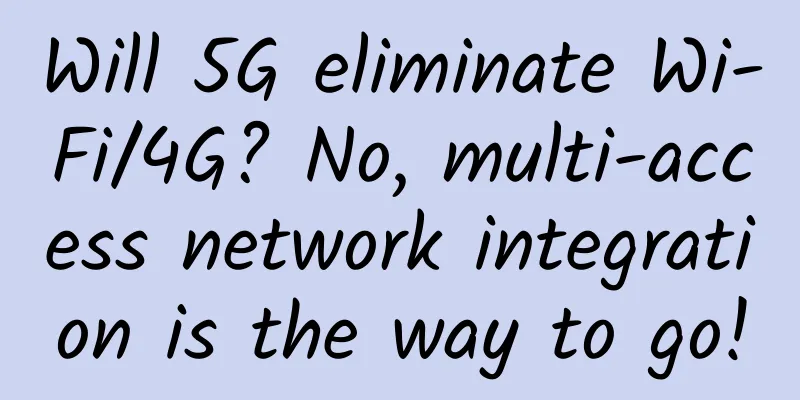Will 5G eliminate Wi-Fi/4G? No, multi-access network integration is the way to go!

|
The advent of 5G brings not only new technologies and services, but also greater inclusiveness, taking into account the integration with other communication networks from the perspective of technical standards and business models. 5G is not omnipotent. Since various mature wireless communication networks have existed for a long time and formed a broad industrial ecosystem, they must have their own advantages in some scenarios. If multiple access networks can be fully integrated and complement each other's advantages, they can bring better experience to users at a low cost to a large extent. In the context of 4G still occupying the mainstream of cellular networks and the continuous upgrading of WiFi technology, how to integrate different wireless access technologies in 5G commercial use deserves attention.
In scenarios with high hotspot capacity, we strive to improve user experience in every possible way As we all know, the International Telecommunication Union (ITU) has defined three major application scenarios for 5G. When my country's IMT2020 (5G) Promotion Group released the "5G Concept White Paper", it split the enhanced mobile broadband (eMBB) scenario defined by the ITU into two scenarios: continuous wide coverage and hotspot high capacity, based on specific application scenarios. Because the two can indeed be achieved through different KPIs, together with low power consumption and large connections (mMTC) and low latency and high reliability (uRLLC), the white paper provides a classification of KPI indicators for each 5G scenario. Source: 5G Concept White Paper It can be seen that hotspot high capacity is a very challenging scenario, because this scenario is basically in a fixed place, and the number of devices connected per unit area is much higher than other scenarios, and at the same time, the experience rate must reach more than 1Gbps, which can be said to be a relatively demanding requirement. Hotspot high capacity generally appears in densely populated office buildings, residential areas, and stadiums, concerts, shopping malls, airports, railway stations and other places with sudden large traffic. Its own characteristics determine that various technologies are needed to meet the needs of hotspot high capacity. On the one hand, although offices and residences may be densely populated, they basically have relatively fixed capacities, and network service providers can design business models to support their capacity needs. However, in stadiums, concerts, shopping malls and other places, the number of people and equipment may suddenly explode, and all devices need to be connected to the Internet, and the requirements for network speed and capacity are very large, which puts huge pressure on the network. For example, when there is no competition in a stadium, the network is idle, but during major events, tens of thousands or even hundreds of thousands of spectators will gather in a short period of time, and each spectator has at least one connected smart device, so even basic communication needs require a large capacity. On the other hand, the emergence of new terminal equipment and technical means has led to a rapid increase in traffic consumption. New forms such as VR viewing and high-definition live broadcasting have emerged, all of which require the network to be highly flexible and have the ability to quickly expand. For example, a football match may require multi-perspective interactive live broadcasting, and the audience can also experience immersive goals through VR devices. In this case, the stadium must not only guarantee the audience's basic communication needs, but also these higher-level communication needs. In previous operations, network service providers would specifically provide communication guarantees in these places, such as adding emergency communication vehicles and temporary base stations. In the deployment of 5G networks, higher millimeter wave frequency bands may be used to increase capacity in hot spots, and beamforming technology may be used to improve system performance. However, some hot spots with high capacity already have other wireless communication networks such as LTE and WLAN deployed. If other networks can be used to share the growth in traffic, it will obviously reduce the pressure and investment in 5G networks. As the author mentioned in the article "How to truly experience the speed of 1G in the 5G era? WiFi has become an important boost!", many operators have planned to adopt traffic offloading technology and cooperate with WiFi operators to achieve the integration of 5G and WiFi in hot spots to carry explosive traffic growth. The integration of multiple wireless accesses, 5G improves user experience in inclusiveness As a typical application scenario in the 5G era, hotspot high capacity has a clear demand for the integration of multiple wireless access networks. In the 5G era, the industry continues to explore and eventually promote the integration of multiple networks for commercial use, mainly due to the needs of multiple network integration generated by the characteristics of 5G services and operations. In terms of business characteristics, 5G faces more diversified business and scenario requirements, higher user experience requirements and lower latency and energy consumption requirements. 5G also needs the help of "external forces" to jointly meet these requirements; in terms of network operation, since different networks coexist in the 5G era, if multi-network integration is not achieved, different networks cannot be flexibly scheduled, resulting in waste of resources. The interoperability between different networks is complex and requires independent maintenance, and the operation and maintenance costs are high. China Telecom Technology Innovation Center has summarized the business and operation requirements of multi-network integration in the 5G era. The requirements for the integration of multiple access technologies put forward by different user experience and network operation requirements are summarized as shown in the following figure: In fact, as early as the 4G era, the industry has done a lot of standardization and commercial work on the integration of LTE and WLAN. 3GPP started the project in the R12 stage to study the collaboration between LTE and WLAN on the wireless access network side. In the subsequent R13 and R14 stages, the enhanced technical standards for the integration of LTE and WLAN were promoted. As early as 2015, the 5G Concept White Paper released by the IMT2020 (5G) Promotion Group pointed out that wireless local area network (WLAN) has become an important supplement to mobile communications, mainly providing data offload in hot spots. The formulation of the next-generation WLAN standard (802.11ax) was launched in early 2014 and is expected to be completed in 2019. Looking ahead to 2020 and beyond, the next-generation WLAN will be deeply integrated with 5G to jointly provide services for users. This expectation is based on the consensus of the industry. In the 5G-related technical specifications, 3GPP proposed the openness of 5G networks. The openness is reflected in the openness and compatibility with the original 4G network on the one hand, and the access to non-3GPP standard networks on the other hand, including WLAN. At present, the 802.11ax standard has been released and has a new name, WiFi 6. It fully adopts mature technologies of mobile communication networks such as MU-MIMO and OFDMA, and can provide better performance in terms of speed, capacity, power consumption, etc., and can be used as the object of 5G multi-wireless technology integration. Recently, South Korean Telecom KT and Belgian network technology company Tessares jointly announced that they have completed the standardization of the next-generation multi-connection access traffic switching and diversion management technology (ATSSS, Access Traffic Steering, Switch and Splitting), and successfully conducted the world's first test of this technology in a 5G commercial network. This technology was developed by KT in cooperation with Apple, Deutsche Telekom, Orange, Cisco and other companies, and can be applied to the integration of multiple networks such as LTE, WiFi, and 5G. This technology complies with the 3GPP R16 specification. Technologies such as ATSSS can fully utilize existing LTE and WiFi network assets without reducing the user experience in 5G networks, fully reflecting the inclusiveness of 5G and reducing 5G investment costs. ATSSS has become a component of the 3GPP unified standard, but in order to provide a seamless experience environment, although there is standard support, the integration of different wireless access networks in the actual existing network is very complex. The integration of multiple networks in 5G commercial use still requires continuous support from the industry chain. |
<<: Five firewall configuration mistakes to avoid
>>: Small router, do you really understand its structure?
Recommend
It turns out that there are so many tricks in O2O search! Meituan Xian Yunsen reveals how to make services smarter
[51CTO.com original article] The Global Software ...
Five ways 5G will change retail
5G is a hot topic - along with Web3.0 and the Met...
Industry Observation: 6G will mainly become an industrial IoT network
Cellular positioning technology for key IoT indus...
Huawei launches intelligent data solution FusionData to unlock data value
[Beijing, China, June 5, 2019] Huawei released it...
How to ensure consistency of Serverless business deployment updates?
Since I started working on Serverless tools, I of...
DCIM vs DMaaS: Solving the Value-Added Problem of Data Center Management as a Service
Despite the adoption of data center infrastructur...
Digital-vm 50% off all VPS, US/Japan/Singapore 1-10Gbps unlimited traffic starting from $3/month
Digital-vm sent a reminder email, saying that the...
The first ICT talent ecosystem white paper was released, and the technical talent gap reached 7.65 million last year
On August 8, Huawei, the China Software Industry ...
China Academy of Information and Communications Technology: China's 5G mobile phone shipments in March reached 27.498 million units, a year-on-year increase of 76.2%
On April 12, the China Academy of Information and...
Ten reasons why it's time to retire traditional routers in branch offices
Over the years, we've dutifully upgraded our ...
SD-WAN is just the first step in WAN automation
Just like self-driving cars, IT networks are beco...
Build telecom-grade WiFi and lay out the entrance to the wireless city?
As early as 2013, the WiFi networks of the three ...
Megalayer September promotion: Hong Kong dual E5 server from 399 yuan/month, Hong Kong 20G high-defense server from 499 yuan/month
Megalayer has launched its September event, offer...
Liu Guangyi: Spectrum unification promotes early commercial use of 5G and smooth evolution of 4G networks to 5G
5G has become the focus of major exhibitions, but...
DogYun Fantasy Beast Palu server pre-sale 400 yuan/month-2*E5-2680v4/128G memory/1TB SSD/50M input 40M output
DogYun (狗云) has launched a pre-sale activity for ...









